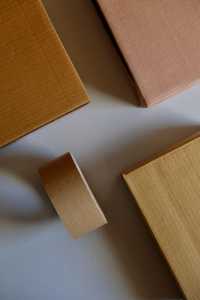Remember how excited you were when you were taking the plastic seal off the box and feeling the smooth white surface of your first iPhone. When you first touched the box, you could sense the device’s importance, quality, and significance. This is not a fluke! Apple planned methodically how they would package their product to correspond with their branding, giving top-of-the-line product innovation and user experience. Types Of Packaging-
With so many packages and box options on the market today, choosing the most appropriate packaging solution for your goods can be challenging. Let’s look at some of the various forms and types of packaging you may utilize to improve your product and client experience!
Table of Contents
1. Paperboard Boxes
Paperboard is a lightweight but sturdy paper-based material. It’s simple to cut and manipulate to make unique shapes and structures. Because of these properties, it’s excellent for bespoke packaging. It’s manufactured by pulping fibrous materials like wood or recovered waste paper, then bleaching it. Paperboard packaging is available in a variety of grades, each suited to specific packaging needs.
Cosmetics, pharmaceuticals, milk and juice, cosmetics, frozen food, and more can be packaged with SBS (or solid bleached sulfate) paperboard. Those who like recycled paper’s natural and environmentally friendly aesthetic, which can be utilized for similar packaging applications, should choose kraft or CUK (coated unbleached kraft) paperboard packaging.
Kraft is sometimes perceived as being less moisture resistant, making it unsuitable for food or frozen goods packaging. Paperboard packaging can seem high-end without the high-end price tag if the appropriate combination of design options is used.
2. Corrugated Boxes
Cardboard is what is often referred to as corrugated boxes. Corrugated boxes, which are used to make huge shipping, shoe, and storage boxes, are what most people think of when they hear the word “cardboard.”
Many people are unaware that corrugated boxes come in a variety of shapes and sizes, depending on the box’s durability and strength. However, identifying a certain corrugated material is simple. How can you figure out what kind of material you’re dealing with? It does this by using corrugated media (also known as fluting).
It’s simple to recognize corrugated material. An outer liner, an internal liner, and a corrugated medium make up the three layers of paper (also known as fluting). Its strength and rigidity are provided by the corrugated media.
Most recycled paper is used to make a corrugated board which is manufactured using massive, high-precision machinery known as corrugators. These types of boards can be reused and recycled as a source of pulp fiber over and over again. There are four different corrugated panels: single-faced, double-faced (single wall), twin wall, and triple wall. They can be used to create packaging with a variety of qualities, capabilities, and durability.
3. Plastic Boxes
From spaceships to paper clips, plastic is employed in a wide range of items. Plastic has already supplanted many traditional materials such as wood, leather, glass, ceramics, and so on.
Plastic box packaging provides various advantages, including being recycled and the fact that they are generally more durable than paperboard boxes. Food quality may be preserved and contamination risks can be avoided by using airtight plastic packaging containers. Plastic packaging is also resistant to breakage and can be stored alongside food in harsh environments.
Another reason why plastic is a popular packing material is that it allows you to display the product from any angle without opening the package. It’s also flexible and lightweight, and it can be used with films or coatings to improve the aesthetic of flexible packaging.
Plastic, contrary to popular opinion, is recyclable because it requires less energy to manufacture new plastic than glass or other materials. Most importantly, it is incredibly cost-effective!
4. Rigid Boxes

I’m sure you’ve always wondered what kind of box Apple or luxury retailers like Rolex, Tiffany & Co, and Marc Jacobs used for packaging their products. Because of its robust and luxurious appearance, you have a feeling it’s a form of cardboard, but you’re not sure. Rigid boxes are made of this sort of cardboard.
A rigid box is built of highly condensed paperboard, four times thicker than the paperboard used in regular folding cartons. The packages that store Apple’s iPhones and iPads, which are two-piece setup rigid boxes, are the simplest real-world example of rigid boxes.
One of the main difference between rigid packaging and flexible packaging is that rigid packaging provides superior product protection. And unlike flexible packaging, most rigid packaging are recyclable.
Cosmetics, jewelry, electronics, and high-end luxury couture are all typical uses for these boxes. Platforms, windows, lids, hinges, compartments, domes, and embossing are all simple to add into a rigid box.
5. Chipboard packaging

Chipboard is essentially a sort of paperboard created from recovered paper stock. It’s simple to cut, fold, and form. It is a low-cost packaging alternative for your goods.
It comes in a variety of densities, and the density of the substance determines its strength. If you wish to print graphics directly on the chipboard, you can treat it with bleach sulfate and CCNB (Clay Coated News Back), which makes the material even more resistant.
Chipboard packaging is not appropriate for heavier objects since the chipboard sheet is a lightweight material used to package cereal, crackers, tissue boxes, and other grocery items. Chipboard can also be quickly weakened by moisture in the storage environment, resulting in discoloration and expansion.
6. Polybags
Polybags, commonly known as pouches or plastic bags are made of thin, flexible plastic film fabric. It is one of the most frequent types of packaging and can hold various objects such as food, flowers, garbage, chemicals, magazines, and so on.
Polybags are strong but light, reusable, and versatile. Polybags can be entirely customized in appearance, style, and size while remaining cost-effective due to their structural simplicity.
Conclusion
Are you embarking on a journey into the realm of product packaging? If that’s the case, there are a lot of things to think about and learn about. Choosing the proper type of packaging materials is one of the most important things to think about during this time.
When it comes to packaging a product, you must first decide on the type of material to use and Types Of Packaging . Go through this article and decide what packaging option can best suit your requirements.


